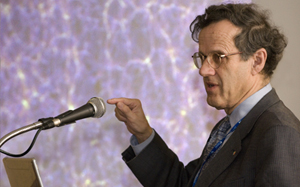Science fare
A major conference honors Darwin while grappling with the “big questions” and daunting challenges that mark this moment in history.
By Benjamin Recchie, AB’03
Photography by Lloyd DeGrane
At the annual conference of the American Association for the Advancement of Science, held in Chicago in February, astronomy and astrophysics professor and Argonne National Laboratory director Robert Rosner explained how researchers at the University and Argonne use advanced simulations and models to answer “big questions.” In this case, “big” describes both the magnitude of the questions (the nature of dark matter and dark energy) and the size of the subjects (large-scale structures in the universe, such as superclusters of galaxies).
The simulations Rosner described in the symposium, “Earth’s History and Future Revealed at the Frontier of Scientific Computing,” have led to major breakthroughs, with the promise for more. Simulations of certain kinds of supernovae, for example, “completely changed how we thought these explosions work.”
One challenge simulations present: replicating the universe well. “Computers always give an answer,” Rosner said. “The question is, is it the correct answer?”
 Simulations and models help scientists like Robert Rosner address “big questions.”
Simulations and models help scientists like Robert Rosner address “big questions.”
Even models that prove wildly inaccurate in one way can provide surprisingly accurate results in other ways. As a metaphorical example Rosner compared Jules Verne’s 1865 novel From the Earth to the Moon with the actual 1960s Project Apollo. Verne’s explorers launched themselves from a cannon while NASA used a Saturn V rocket, but both Verne’s projectile and the Apollo spacecraft were launched from central Florida, were approximately the same size, and carried a crew of three. Even the cost Verne estimated for his “moon shot,” adjusted for inflation, was remarkably close to NASA’s actual figure.
Ways that science and society intersect—like that connection between reality and fiction—held a prominent place at the meeting, which drew almost 6,000 people. Of nearly 175 symposia over five days, 24 featured researchers from the University, Argonne, and Fermilab. Former Vice President Al Gore addressed the group on climate change and urged the scientists to influence public policy.
With Charles Darwin’s 200th birthday on February 12, and the 150th anniversary of his Origin of Species, natural selection and evolution were popular themes. Talks included “Natural Security: A Darwinian Approach to a Dangerous World” and “Celebrating Darwin at 200: Explaining How Human Morality Evolved.”
University President Robert J. Zimmer served as a local cochair. “It is common at most any time for speakers to refer to the uniqueness of the present moment,” Zimmer said in his introductory remarks. “It is abundantly clear that the current situation is in fact filled with urgent challenges—economic, policy, scientific, and international challenges—that we must confront.”
Like Gore, Zimmer encouraged the audience to bridge the gap between science and public policy. He expressed “optimism that we are entering a period of renewed attention to science in American politics,” lauding the new White House’s “explicit call for ideas over ideology and data over dogma.” The crowd applauded when he mentioned the “former University of Chicago faculty member [serving] as president of the United States.”
Return to top